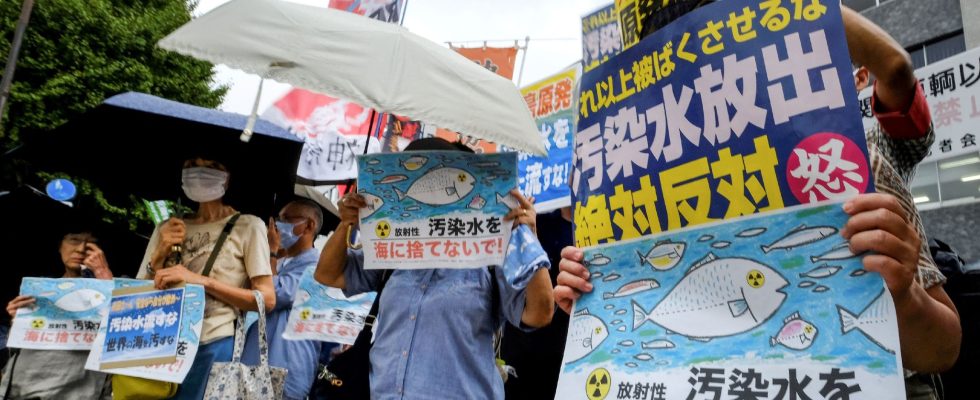Japan has planned to begin the evacuation into the Pacific Ocean of more than a million liters of water from the damaged Fukushima Daiichi nuclear power plant, devastated by a giant tsunami in 2011, on Thursday. According to Tokyo and international experts , this operation is safe because the water has been treated beforehand and the process will be extremely gradual. But some neighboring countries, particularly China, are alarmed.
Why discharge into the ocean?
The Fukushima Daiichi power plant generates more than 100,000 liters of contaminated water per day on average – water from rain, groundwater or injections needed to permanently cool the cores of its reactors which melted down in 2011 .
The water is collected, filtered and stored on site, but the available capacities are soon saturated: 1.34 million tonnes, the equivalent of almost 540 Olympic swimming pools, have been accumulated in more than a thousand giant cisterns. .
After years of reflection, Japan opted in 2021 for the solution of discharge into the sea one kilometer from the coast, via an underwater conduit built for this purpose. Under the supervision of the International Atomic Energy Agency (IAEA), the process should last until the beginning of the 2050s, at the rate of a maximum of 500,000 liters evacuated per day, according to Tepco, the operator of the plant in dismantling course.
Why is the discharge of these waters arousing criticism?
Environmental organizations have criticized the Japanese plan, such as Greenpeace, which accuses the Japanese government of minimizing radiation risks. Japanese fishermen also fear that this will damage the image of their products, both in the domestic market and abroad.
On the side of neighboring countries, China accuses Japan of rejecting “arbitrarily” at sea the water of Fukushima. Beijing called the Japanese plan “extremely selfish and irresponsible” and criticized Tokyo for wanting to use the Pacific Ocean as a “sewer”.
China decided in July to ban food imports from ten Japanese counties, including Fukushima, citing security concerns. Radiation tests on foodstuffs from the rest of Japan have also been implemented in China.
Seoul, whose relations with Tokyo have warmed in recent months, expressed no objections. But the opposition and the South Korean population are worried: demonstrations have taken place in the country and panicked consumers have stockpiled sea salt, for fear that it will soon be contaminated.
Hong Kong Chief Executive John Lee said on Tuesday he had ordered his government to “immediately” implement cuts on imports of certain Japanese food products.
How does Japan respond?
Japan asserts that this operation poses no threat to the marine environment and human health. The International Atomic Energy Agency (IAEA), which controls the project, agrees and gave the green light in July.
The Japanese authorities and Tepco have been trying for months to convince the skeptics, by organizing visits to the Fukushima plant, technical information sessions, or even by broadcasting live on YouTube an experiment where fish swim in pools of treated and diluted water. Tokyo is also fighting against the online disinformation that has flourished in the face of its project.
What the experts say
These waters were treated beforehand to rid them of their radioactive substances, with the exception of tritium, which could not be removed with existing technologies.
However, tritium is a radionuclide naturally present in seawater and whose radiological impact is low. If inhaled or ingested, tritium can pose a risk, but only very high doses are harmful to human health, experts say.
In this case, Tepco plans to dilute this “tritiated” water to reduce its level of radioactivity to less than 1,500 becquerels per liter (Bq/L), well below the national standards of 60,000 Bq/L for this category. .
For decades, tritium has been regularly released into the water by nuclear power plants in operation around the world, as well as by nuclear waste reprocessing plants such as that of La Hague in France, reminds AFP Tony Hooker, a radiation specialist from the University of Adelaide (Australia). “We have not identified any environmental or health impact,” he said.
